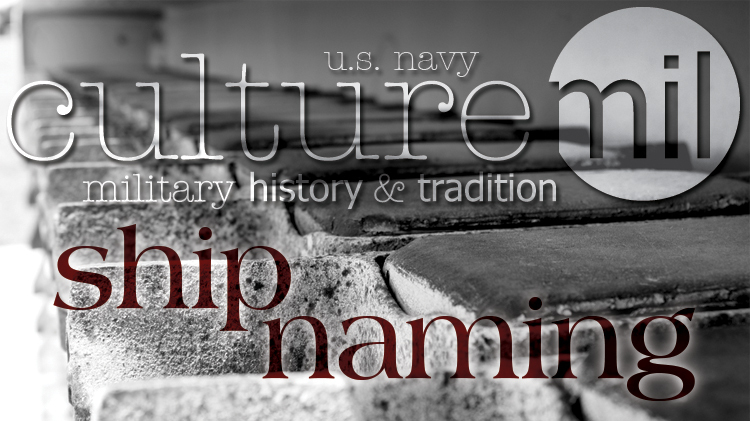- American institutions and ideals: Congress, Independence
- Heroes and patriots: Hancock
- Represent of the U.S. when being donated abroad: America
- American places: Virginia, Boston
- Positive character traits: Diligence
- Classical names: Argus, Syren
- Small, stinging creatures: Hornet, Wasp
- “all of the ships, of the Navy of the United States, now building, or hereafter to be built, shall be named by the Secretary of the Navy, under the direction of the President of the United States, according to the following rule, to wit: those of the first class shall be called after the States of this Union; those of the second class after the rivers; and those of the third class after the principal cities and towns; taking care that no two vessels of the navy shall bear the same name.” The last portion of the provision, “taking care that no two vessels of the navy shall bear the same name,” remains part of current law.
- First Class: ships armed with 40 or more guns
- Second Class: ships armed with fewer than 40 but more than 20 guns
- Name sources expanded to include rivers and principal towns
- Third Class: ships armed with 20 guns or less
- “change the names of any vessels purchased for use of the Navy Department...” (provision remains in current law)
- “all first-class battleships and monitors [shallow-draft coast-defense ships completed between 1891 and 1903, armed with heavy guns] shall be named for the States, and shall not be named for any city, place, or person, until the names of the States have been exhausted, provided that nothing herein contained shall be construed as to interfere with the names of states already assigned to any such battleship or monitor.”
- The Chief of Naval Operations shall be responsible for ... the assignment of classification for administrative purposes to water-borne craft and the designation of status for each ship and service craft. ....
- Commissioned vessels and craft shall be called “United States Ship” or “U.S.S.”
- Civilian manned ships, of the Military Sealift Command or other commands, designated “active status, in service” shall be called “United States Naval Ship” or “U.S.N.S.”
- Ships and service craft designated “active status, in service,” except those described by paragraph 3 of this article, shall be referred to by name, when assigned, classification, and hull number (e.g., “HIGH POINT PCH-1” or “YOGN-8”).
- https://www.history.navy.mil/browse-by-topic/heritage/customs-and-traditions0/ship-naming.html
- https://www.mentalfloss.com/article/13040/11-things-you-might-not-know-about-us-navy
Written by Jenifer Chrisman on July 23, 2020.
“You can’t cross the sea merely by standing and staring at the water.”
– Rabindranath Tagore
Prior to 1819, Continental and early federal Navy ships derived their names from a variety of sources. From full battleships to schooners, they ran a gamut of personal names, traits and locations:
Congress formally placed the Secretary of the Navy as responsible for assigning names to Navy ships on March 3, 1819. The act stated that:
An act on June 12, 1858, added “steamship” to the nomenclature and officially defined ship “classes” by the number of their guns:
An act August 5, 1861, authorized the Secretary of the Navy to:
An act on May 4, 1898, stated:
On January 8, 1907, Executive Order 549 (United States Navy Regulations, 1990, Article 0406), issued by President Theodore Roosevelt established the present-day standards:
To help expedite the naming decisions, the Navy History and Heritage Command (NHHC) compiles a list of primary and alternate recommendations each year. These recommendations are based on research into the history of the Navy, as well as suggestions submitted by the public, service members and Navy veterans. The names encompass types of ships being built, names borne by previous ships that distinguished themselves; the distribution of geographic names of ships of the fleet; names recommended by individuals and groups; and names of national figures, naval leaders and deceased members of the Navy and Marine Corps who have been honored for extraordinary achievement or heroism.
The compiled list is sent up the chain of command by way of the Chief of Naval Operations. He in turn signs a memorandum with the recommendations for the building program’s current year and passes it on the Secretary of the Navy. After due deliberation and taking the memorandum into account, along with his own thoughts on the matter and any recommendations he personally receives, he then selects and announces the new names.
The Secretary of the Navy also selects and invites each sponsor (the person who will be christening the ship) for the ship naming ceremony. Ships names are generally assigned before they are christened. When the ship is being named after an individual, the oldest living female relative is sought to perform the role. For all other ship names, the wives of public officials or senior naval officers are customarily honored with the task.
Ship naming has evolved over time but remains in integral part of the Navy – past, present and future. Each name makes its own mark, leaving a tangible trace upon naval history.
Sources:




